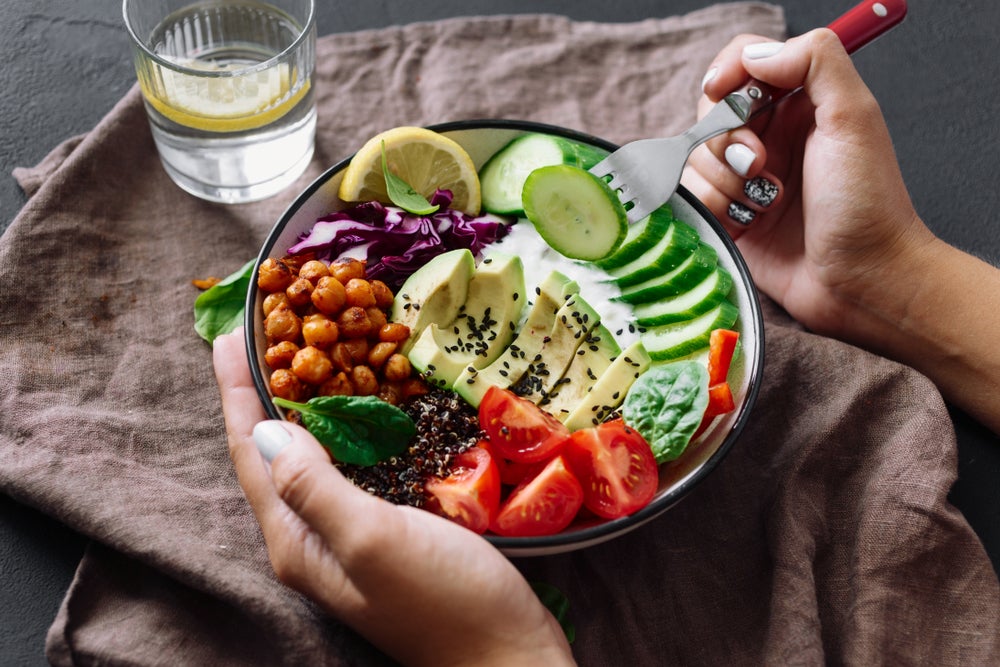10 Steps for Eating Well after Hysterectomy
Now that your hysterectomy is behind you and your recovery is over, you can take the opportunity to become healthier for this next stage of life. One of the ways you can improve your health is to make healthier choices when it comes to your diet.
Rather than follow crash diets, eliminate food groups, or skip meals to help you control your diet, learn to make healthy choices. You should also take small steps rather than make drastic changes which might not last.
Here are 10 ways you can improve your diet in a simple and sensible manner.
1. Write down everything you eat and drink.
Writing down everything you consume can help you realize what you are eating and when you are eating it. You may not be aware of how much you are snacking until you make a point of writing down every morsel of food you eat. You may also find you are drinking far more calories than you had realized.
2. Replace unhealthy choices with healthier ones–slowly.
Once you see what you eat, you can start to replace the unhealthiest items with healthier choices. If you find you have been eating a candy bar every day at 3:00 PM, you can plan to have a healthy snack at that time. If you discover you are drinking a number of sodas throughout the day, you can plan to drink more water and replace some of the sodas with more healthy options. Pay attention to whether you are snacking on salty or sweet items so you can replace them with healthier choices that will satisfy that craving.
3. Monitor portions.
While you work to make your diet healthier, you can start working on portion sizes. If you are going to eat something not quite so healthy, keep the portion size small and limit how much of it you eat. Rather than have higher fat options make up the biggest portion of any meal, add more fruits and veggies and make them the larger part of your meals.
4. Make foods count.
Empty calories can leave you hungry so that you continue to graze throughout the day. Foods higher in protein or fiber can leave you feeling fuller so you aren’t as quick to snack and overeat. Fat is important, but it should be healthier fats. Try to choose whole-grains, nuts, flavorful veggies, and mouth-watering fruits rather than candy bars, potato chips, and white bread with butter.
5. Beware the toppings.
It can be easy to pile on fat and calories with toppings, garnishments, and dressings. When adding dressing to your salad, loading up your baked potato, and dipping your meat or veggies, consider alternative options that are lower in fat and calories. Healthier choices can include salsa, mustard, or a light vinaigrette.
6. Watch the meat.
When making meat choices, you can choose leaner options to minimize calories. Removing skin, fat, and breading can help as well. Instead of frying, you can grill, bake, or broil your meats so as not add additional calories. Adding more veggies to the dish, such as with stir-fry, can allow you to have the flavor of meat without making it such a large portion of your meal.
7. Eat on a schedule.
Eating on a schedule can get your body in a pattern to help keep your appetite controlled and thus prevent overeating and too much snacking. Build in set meal times as well as a couple snacks each day.
8. Plan your meals in advance.
Meal planning can help you make better choices and control portion sizes. It can also help you when shopping–if you buy only what you need for your planned meals, you will have fewer tempting foods around to snack on.
9. Drink more water.
It’s possible to mistake thirst for hunger, and drinks with artificial sweeteners may also stimulate your appetite. Drinking at least 8 glasses of water per day can help quench your thirst without adding unnecessary calories to your diet.
10. Give it time.
It you make too many drastic changes all at once, you may feel dissatisfied and hungry. Rather than overhaul your diet all at once, make slow but steady changes. Decrease portion sizes a little at a time. Slowly replace your snacks with healthier options. Make small, but permanent changes to your meals. If you make slow but steady changes, they are more apt to become long-lasting once. If you make drastic changes, you may cave and binge on foods you have been craving but denying yourself.
This content was written by staff of HysterSisters.com by non-medical professionals based on discussions, resources and input from other patients for the purpose of patient-to-patient support. Reprinted with permission: 10 Steps for Eating Well after Hysterectomy
Shutterstock.com/Anna Kucher







